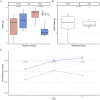Dietary fiber induces a fat preference associated with the gut microbiota
- PMID: 38985782
- PMCID: PMC11236109
- DOI: 10.1371/journal.pone.0305849
Dietary fiber induces a fat preference associated with the gut microbiota
Abstract
Eating behavior is essential to human health. However, whether future eating behavior is subjected to the conditioning of preceding dietary composition is unknown. This study aimed to investigate the effect of dietary fiber consumption on subsequent nutrient-specific food preferences between palatable high-fat and high-sugar diets and explore its correlation with the gut microbiota. C57BL/6NJcl male mice were subjected to a 2-week dietary intervention and fed either a control (n = 6) or inulin (n = 6) diet. Afterward, all mice were subjected to a 3-day eating behavioral test to self-select from the simultaneously presented high-fat and high-sugar diets. The test diet feed intakes were recorded, and the mice's fecal samples were analyzed to evaluate the gut microbiota composition. The inulin-conditioned mice exhibited a preference for the high-fat diet over the high-sugar diet, associated with distinct gut microbiota composition profiles between the inulin-conditioned and control mice. The gut microbiota Oscillospiraceae sp., Bacteroides acidifaciens, and Clostridiales sp. positively correlated with a preference for fat. Further studies with fecal microbiota transplantation and eating behavior-related neurotransmitter analyses are warranted to establish the causal role of gut microbiota on host food preferences. Food preferences induced by dietary intervention are a novel observation, and the gut microbiome may be associated with this preference.
Copyright: © 2024 Liow et al. This is an open access article distributed under the terms of the Creative Commons Attribution License, which permits unrestricted use, distribution, and reproduction in any medium, provided the original author and source are credited.
Conflict of interest statement
The authors have declared that no competing interests exist.
Figures




References
MeSH terms
Substances
LinkOut - more resources
Full Text Sources
Medical

